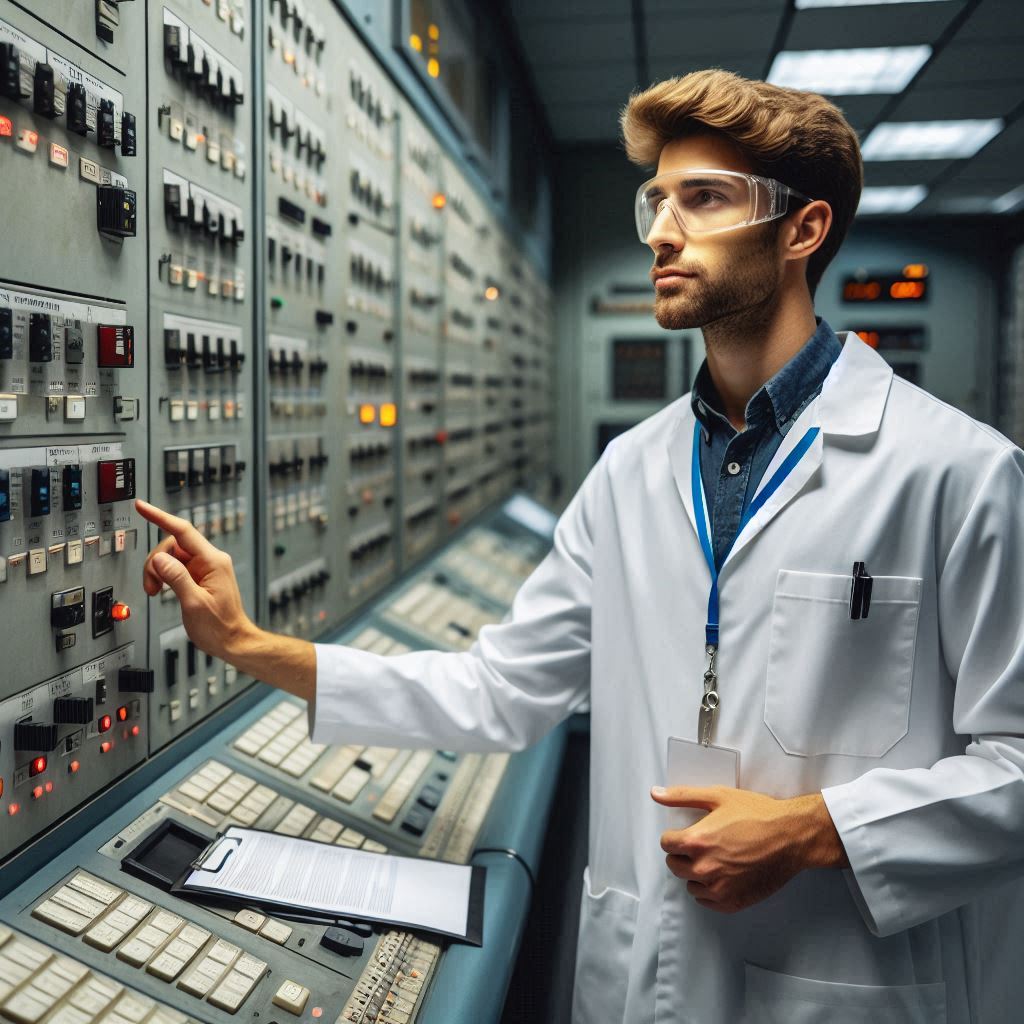Introduction
Nuclear engineering focuses on harnessing nuclear reactions for energy and other applications.
This field is crucial in power generation, medicine, and research.
Nuclear reactors provide a significant portion of the world‘s electricity, showcasing the field’s importance.
However, nuclear engineering comes with inherent risks and hazards.
The process involves handling radioactive materials, which can be harmful if not managed correctly.
Accidents at nuclear facilities can lead to severe environmental and health consequences.
The catastrophic events at Chernobyl and Fukushima highlight the dangers associated with nuclear power.
Given these risks, safety measures in nuclear engineering are paramount.
Engineers must implement rigorous protocols to prevent accidents and mitigate potential impacts.
They use advanced technology and strict regulations to ensure safe operations.
Regular training and safety drills are crucial for all personnel working in the field.
The significance of safety in nuclear engineering cannot be overstated.
Effective safety measures protect both people and the environment from potential harm.
By prioritizing safety, the nuclear industry can continue to provide its benefits while minimizing risks.
As technology advances, maintaining high safety standards will remain essential to the field‘s success and public trust.
History of nuclear accidents
Major Nuclear Accidents Like Chernobyl and Fukushima
The Chernobyl disaster in 1986 was a catastrophic event.
A reactor explosion released radioactive materials into the atmosphere.
The Fukushima Daiichi accident in 2011 resulted from a massive earthquake and tsunami.
Both incidents caused severe harm to human lives and the environment.
These accidents underscored the importance of having effective emergency preparedness plans.
Devastating Consequences of These Accidents on Human Lives and the Environment
Chernobyl exposed thousands to dangerous radiation levels.
It led to numerous health issues, including cancer and birth defects.
The environment suffered long-term contamination, affecting wildlife and ecosystems.
Fukushima caused widespread evacuation, displacing thousands of residents.
Radiation contamination impacted land and water, creating long-lasting challenges.
These incidents show how critical it is to prepare for emergencies to protect lives and the environment.
Need for Stringent Safety Protocols in Nuclear Engineering
Effective safety protocols are essential in nuclear engineering.
Regular drills and simulation exercises are vital for training employees.
Drills simulate real-life scenarios, helping staff practice emergency protocols.
This hands-on experience improves response times and boosts confidence.
Employees become familiar with evacuation routes and safety equipment.
They also learn to manage stress and make quick decisions under pressure.
Simulation exercises test the effectiveness of emergency plans.
They reveal weaknesses and highlight areas for improvement.
By conducting these simulations, facilities can refine their strategies and enhance their readiness.
Read: The Role of Aerospace Engineers in Satellite Development
Importance of safety culture
What Safety Culture Means in the Context of Nuclear Engineering
Safety culture in nuclear engineering refers to the collective attitudes and practices regarding safety within an organization.
It encompasses the commitment to safety from all levels of staff, from executives to field workers.
This culture prioritizes safety in every operation and decision.
It instills a proactive approach to identifying and addressing potential hazards.
Discuss How a Strong Safety Culture Can Prevent Accidents and Minimize Risks
A strong safety culture can significantly prevent accidents and minimize risks.
When safety is a core value, employees are more likely to adhere to protocols and report unsafe conditions.
This vigilance helps identify issues before they escalate into serious problems.
Regular training and a focus on safety reinforce the importance of adhering to procedures.
This proactive stance helps avoid accidents and ensures that risks are managed effectively.
How a strong safety culture can prevent accidents and minimize risks
A strong safety culture is pivotal in preventing accidents and minimizing risks in nuclear engineering.
This culture prioritizes safety in every aspect of operations, from the top management down to every worker.
When safety is deeply ingrained in the organizational values, it fosters an environment where employees are vigilant and proactive about potential hazards.
Regular training and open communication ensure that everyone is well-informed about safety protocols and the importance of adhering to them.
When safety is viewed as a shared responsibility, employees are more likely to report unsafe conditions or near-misses, allowing for timely corrective actions.
Additionally, a safety-first mindset promotes thorough risk assessments and rigorous adherence to regulatory standards.
By continually reviewing and improving safety procedures, the likelihood of accidents is significantly reduced.
In essence, a robust safety culture creates a proactive rather than reactive approach to managing risks, ensuring that safety is an integral part of every decision and action within the nuclear engineering field.
Examples of Companies with Effective Safety Cultures in the Nuclear Industry
Several companies exemplify effective safety cultures in the nuclear industry.
For instance, the Nuclear Regulatory Commission (NRC) enforces rigorous safety standards and promotes a strong safety culture across facilities.
Similarly, companies like Exelon and EDF Energy are known for their robust safety practices.
They consistently invest in training, conduct regular drills, and maintain open communication channels.
These practices ensure their facilities operate safely and efficiently, highlighting the importance of a strong safety culture in preventing accidents and managing risks.
Read: Aerospace Engineering in Commercial Spaceflight
Regulatory Framework for Nuclear Safety
Role of Regulatory Bodies Like the Nuclear Regulatory Commission in Ensuring Safety in Nuclear Engineering
Regulatory bodies like the Nuclear Regulatory Commission (NRC) play a crucial role in ensuring safety in nuclear engineering.
They establish and enforce safety standards for nuclear facilities.
The NRC oversees compliance with these standards to prevent accidents and ensure public safety.
Their regulations cover everything from operational procedures to emergency preparedness.
Strict Guidelines and Regulations That Govern Nuclear Facilities
Nuclear facilities are governed by strict guidelines and regulations.
These include detailed protocols for emergency preparedness, safety equipment, and employee training.
Regulations mandate regular inspections and updates to safety procedures.
Facilities must follow these rules to maintain operational safety and address potential hazards.
How Adherence to These Regulations Is Crucial for Preventing Accidents
Adherence to regulatory guidelines is crucial for preventing accidents in nuclear engineering.
Compliance ensures that safety measures are implemented correctly and that potential risks are managed effectively.
Regular audits and inspections by regulatory bodies help identify and address any deficiencies.
By following these regulations, facilities can prevent accidents and safeguard both employees and the public.
Effective emergency response relies heavily on communication and coordination.
Clear communication channels ensure that all team members receive timely instructions.
Coordination between departments and external agencies is crucial for a seamless response.
It prevents confusion and overlaps, ensuring that every aspect of the emergency is managed efficiently.
Read: Essential Aerospace Engineering Textbooks

Safety Measures in Nuclear Facilities
Common Safety Measures Implemented in Nuclear Power Plants and Research Facilities
Nuclear power plants and research facilities implement several safety measures.
These include robust safety equipment, detailed emergency protocols, and comprehensive training programs.
Safety equipment, such as radiation detectors and protective suits, safeguards employees from exposure.
Emergency protocols outline clear steps for dealing with various scenarios, from minor incidents to major accidents.
Training programs ensure that staff are well-versed in these protocols and can execute them efficiently.
Use of Safety Equipment, Emergency Protocols, and Training Programs for Employees
Safety equipment is crucial for protecting workers from potential hazards.
Facilities provide personal protective equipment (PPE) and install advanced monitoring systems.
These tools help detect and mitigate risks associated with radiation and other dangers.
Emergency protocols guide employees on how to handle specific situations, including evacuation procedures and communication strategies.
They ensure that everyone knows their role and responsibilities during an emergency.
Training programs are vital for preparing staff to respond effectively.
Regular drills simulate emergency scenarios, allowing employees to practice and refine their skills.
These exercises enhance their ability to make quick decisions under pressure and ensure familiarity with emergency procedures.
Training also includes learning how to use safety equipment properly and understanding how to coordinate with other team members
Importance of Regular Maintenance and Inspections
- Regular maintenance and inspections are crucial for identifying and addressing potential safety hazards in nuclear facilities.
- Inspections help to ensure that equipment is in good working condition and that safety protocols are being followed correctly.
- Maintenance activities such as testing equipment, replacing worn parts, and conducting safety drills help to prevent accidents and keep employees safe.
- By conducting regular maintenance and inspections, nuclear facilities can minimize risks and maintain a safe working environment for employees and the surrounding community.
Read: The Impact of Aerospace Engineering on Modern Life
Risk assessment in nuclear engineering
The Process of Risk Assessment in the Nuclear Industry
Risk assessment is the foundation of emergency preparedness.
It involves identifying potential hazards and evaluating their impacts.
The process starts with a thorough analysis of all possible risks.
Engineers and safety experts assess each risk’s likelihood and potential consequences.
This helps in prioritizing which hazards require more focus.
Effective risk assessments lead to the development of targeted mitigation strategies.
How Risk Assessments Help Identify Potential Hazards and Develop Mitigation Strategies
Risk assessments are crucial for identifying potential hazards in a nuclear facility.
They help in pinpointing specific risks such as equipment failures, human errors, and environmental factors.
Once hazards are identified, mitigation strategies are developed to manage them.
These strategies might include upgrading equipment, revising protocols, and enhancing training programs.
By addressing these risks proactively, facilities can prevent accidents and ensure safety.
Importance of Ongoing Risk Assessments to Adapt to Changing Conditions
Ongoing risk assessments are essential for adapting to changing conditions.
The nuclear industry is dynamic, with evolving technologies and regulatory standards.
Regular updates to risk assessments ensure that new hazards are identified and addressed.
This continuous evaluation helps facilities stay ahead of potential issues and maintain safety.
Adapting risk management strategies to reflect current conditions is crucial for effective emergency preparedness.
Transform Your Career Today
Unlock a personalized career strategy that drives real results. Get tailored advice and a roadmap designed just for you.
Start NowEmergency preparedness and response
Importance of Emergency Preparedness Plans in Nuclear Engineering
Emergency preparedness plans are crucial in nuclear engineering.
These plans ensure that facilities can effectively respond to potential crises.
They outline procedures to follow during emergencies, reducing the risk of accidents and protecting lives.
A well-developed plan is essential for maintaining safety and regulatory compliance.
How Drills and Simulation Exercises Help Train Employees for Emergency Situations
Drills and simulation exercises are vital for training employees in nuclear facilities.
These activities simulate real-life emergencies, allowing staff to practice their response actions.
Through regular drills, employees become familiar with emergency procedures, evacuation routes, and the operation of safety equipment.
This hands-on experience builds confidence and improves response times during actual emergencies.
Simulation exercises are particularly useful for testing and refining emergency plans.
They reveal potential weaknesses in the procedures and help identify areas for improvement.
By conducting these exercises, facilities can adjust their strategies and enhance their overall preparedness.
The experience gained from these drills is invaluable for ensuring that all team members know their roles and responsibilities during a crisis.
The Role of Communication and Coordination in Effective Emergency Response
Effective emergency response depends heavily on communication and coordination.
Clear and timely communication ensures that all team members receive accurate instructions and updates.
It helps in directing personnel, managing resources, and coordinating with external agencies.
Proper communication channels prevent misunderstandings and ensure that everyone is aligned with the response strategy.
Coordination between departments and with local authorities is essential for managing emergencies efficiently.
It avoids confusion and duplication of efforts, ensuring a streamlined response.
Regularly updating emergency plans and incorporating feedback from drills enhances this coordination.
By continuously improving communication strategies, facilities can ensure a more effective and organized response to emergencies.
Learn More: How to Become a Field Service Technician
Public perception and trust
Impact of nuclear accidents on public perception
Nuclear accidents, such as the infamous incidents at Chernobyl and Fukushima, have had a lasting impact on public perception of nuclear engineering.
These catastrophic events have instilled fear and skepticism in the minds of people worldwide.
The idea of nuclear energy has become synonymous with danger and disaster in the eyes of many individuals.
Rebuilding trust through safety measures
To regain the trust of the public, nuclear engineering must prioritize safety measures above all else.
Stringent regulations, thorough risk assessments, and continuous monitoring of nuclear facilities are crucial in ensuring the safety of both workers and the surrounding communities.
By demonstrating a commitment to safety, the industry can begin to rebuild public trust and confidence in nuclear technology.
Successful communication strategies
Communication plays a pivotal role in addressing public concerns and dispelling myths surrounding nuclear engineering.
Engaging with the community through transparent and informative dialogue is essential in fostering understanding and trust.
For example, creating educational campaigns, hosting public forums, and providing regular updates on safety protocols are effective ways to communicate with the public and alleviate fears and misconceptions.
Conclusion
Safety in nuclear engineering is paramount.
We‘ve explored how rigorous safety protocols prevent accidents and protect lives.
Understanding and adhering to safety standards minimizes risks associated with nuclear energy.
The role of safety systems, regular inspections, and emergency preparedness all contribute to a secure operational environment.
Reiterating, the importance of safety cannot be overstated.
Nuclear engineering involves complex systems where even minor failures can have severe consequences.
Implementing robust safety measures is essential to avoid disasters and safeguard both personnel and the public.
Continuous improvement and strict adherence to safety regulations are crucial for maintaining high safety standards.
Encouraging ongoing efforts is vital.
The nuclear industry must prioritize safety at all stages, from design to decommissioning.
Investing in advanced safety technologies and fostering a culture of safety awareness ensures that potential risks are managed effectively.
Collaborative efforts between engineers, regulators, and organizations strengthen safety protocols and enhance industry standards.
By committing to these practices, the nuclear industry can continue to harness the benefits of nuclear energy while ensuring the highest levels of safety.
Let us remain vigilant and dedicated to improving safety measures, protecting lives, and advancing nuclear technology responsibly.
[E-Books for Sale]
The Big Book of 500 High-Paying Jobs in America: Unlock Your Earning Potential
$19.99 • 500 High-Paying Jobs • 330 pages
Explore 500 high-paying jobs in America and learn how to boost your career, earn more, and achieve success!
See All 500 High-Paying Jobs of this E-Book
1001 Professions Without a Degree: High-Paying American Jobs You Can Start Now
$19.99 • 1001 Professions Without a Degree • 174 pages
Discover 1001 high-paying jobs without a degree! Unlock career tips, skills, and success strategies for just $19.99!




